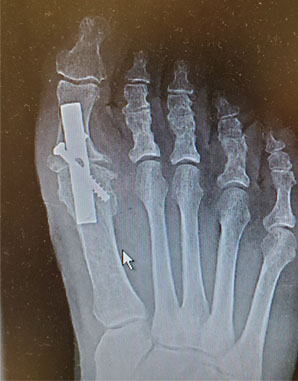What is Hallux Limitus?
Hallux is the medical term for the big toe. Limitus just means stiffness or limitation of motion. Due to a number of possible causes, the cartilage in the big toe joint can become worn down leading to osteoarthritis (aka degenerative joint disease) of the joint. This type of arthritis can occur in any joint in the human body. Over time the motion of the joint becomes stiffer, may become painful, and prominent bone spurs can form which are usually on top of the joint. If the condition progresses the joint can become very stiff with little to no motion remaining. This is called hallux rigidus and is essentially “bone on bone” arthritis of the joint.
What Causes Hallux Limitus?
- Structural deformities of the bones in the joint can predispose it to this condition. Most commonly a long or elevated first metatarsal bone.
- Wear and tear. Like a tire on a car, the cartilage in the joint can get worn out due to the many miles walked and stresses put on the joint over a lifetime.
- Previous injury, especially breaking (fracturing) the big toe into the joint. This damages the cartilage permanently setting the stage for future arthritic changes.
- Other arthritic problems such as gout, infection in the joint, or rheumatoid arthritis can damage the joint.
Symptoms of Hallux Limitus
- Pain with motion of the big toe joint
- Stiffness of the joint which may be accompanied by popping or cracking sensations called crepitus
- Swelling of the great toe joint
- Hard bone spurs may form around the joint. This can create a painful lump which becomes irritated with tight shoes, usually on top of the joint.
- A painful callus may form on the underside of the big toe as a result of the limited joint flexibility which causes excess pressure there.
Non-Surgical Treatment of Hallux Limitus
Diagnosis is made by performing a physical exam of the foot. Your podiatrist will often take x-rays to further assess the extent of joint damage.
- Anti-inflammatories (NSAIDs), both oral and topical can help alleviate pain
- Stiff or rocker-soled shoes can help lessen stress across the joint
- Steroid injections may provide several months of relief
- Orthotics may help improve the mechanics of the joint and lessen pain
- Physical therapy can help improve motion of the joint and may decrease pain.

Surgical Treatment of Hallux Limitus
If conservative therapy fails there are surgical procedures that can help lessen or sometimes eliminate the pain altogether. If the condition is mild then removing the painful spurs and drilling any areas of damaged cartilage to promote fibrocartilage formation can help. This procedure is called a cheilectomy. Occasionally an osteotomy may also be performed in which surgical cuts are made in the bone to correct structural abnormalities. This may be held in place with screws, pins or wires while the bone heals. There are also synthetic implants that can be used to replace the joint, similar to knees and hips. This has the benefit of maintaining some motion in the joint. However, these implants can sometimes wear out over time requiring revisional surgery. When the joint damage is severe, the most effective procedure may be fusion (aka arthrodesis) of the great toe joint. The bones are fused together on both sides of the joint effectively eliminating the painful motion which is occurring. This will typically require a plate and several screws to hold the bones in place. Although the joint no longer moves, this usually ensures the toe is pain free. Your age and activity level will play a big factor in deciding which procedure is best for you.
If you think you are suffering from this condition please contact us so that we can set up an evaluation and help lessen your pain.

Hallux Limitus – Ankle and Foot Injury Specialist
Judd Davis, DPM with A New Step Foot & Ankle Clinics is a compassionate podiatrist (foot and ankle doctor) who helps patients with hallux limitus, foot arthritis and many other foot or ankle problems.


